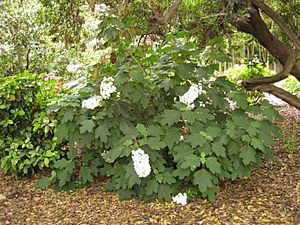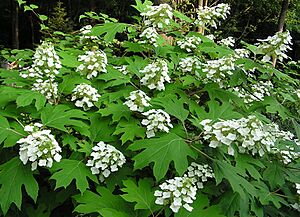Oakleaf hydrangea facts for kids
Quick facts for kids Oakleaf hydrangea |
|
|---|---|
 |
|
| Conservation status | |
| Scientific classification | |
| Genus: |
Hydrangea
|
| Species: |
quercifolia
|
The Hydrangea quercifolia, also called the oakleaf hydrangea, is a beautiful flowering plant. It belongs to the Hydrangeaceae family. This plant naturally grows in the southeastern United States. You can find it in woodland areas from North Carolina to Louisiana. It's a deciduous shrub, meaning its leaves fall off in autumn. It has lovely white flowers and is a popular plant for gardens. Many different types, called cultivars, are sold in stores.
Contents
What's in a Name?
The Oakleaf Hydrangea was first described by an American botanist named William Bartram. The name Hydrangea comes from two Latin words: hydor, meaning "water", and aggeion, meaning "cup". This refers to the cup-like shape of its fruit. The second part of its name, quercifolia, also comes from Latin. Quercus means "oak", and folium means "leaf". So, its name literally means "water cup with oak leaves"!
What Does It Look Like?
The Oakleaf Hydrangea is a deciduous shrub that can grow from 3 to 12 feet (about 1 to 3.5 meters) tall. It often grows in groups because it sends out new shoots from underground stems. Young stems have soft, light brown bark. Older stems have pretty cinnamon-tan-orange bark that peels off in thin pieces.
Its leaves are yellowish-green to dark green on top. They are silvery-white underneath. Each leaf has three, five, or seven pointed lobes. They can be 4 to 12 inches (10 to 30 centimeters) long and almost as wide. These leaves look a lot like the leaves of some oak trees. Plants that grow in shady spots usually have bigger leaves than those in sunny areas. In autumn, the leaves turn amazing shades of red, bronze, and purple. These colors often stay on the plant through winter, along with the dried flower heads.
Beautiful Flowers
The flowers of the Oakleaf Hydrangea grow in tall, cone-shaped clusters. These clusters are called panicles. They can be 6 to 12 inches (15 to 30 centimeters) tall and 3 to 5 inches (7.5 to 12.5 centimeters) wide. When they first appear, the flowers are creamy white. As they get older, they turn pink. By autumn and winter, they become a dry, papery, rusty-brown color.
Unlike some other hydrangeas, like the bigleaf hydrangea, the color of the Oakleaf Hydrangea's flowers does not change based on the soil's pH level. The Oakleaf Hydrangea and the peegee hydrangea are special. They are the only hydrangeas that have cone-shaped flower clusters. Most other hydrangeas have round or flat-topped flower clusters.
Where It Grows Naturally
The Oakleaf Hydrangea is native to the southeastern part of North America. It grows in forests with different kinds of hardwood trees. You can often find it along streams or on forested hillsides. It usually prefers soils that contain calcium, often where limestone is close to the ground. This shrub typically grows under taller trees like oaks, hickories, magnolias, and American beeches.
Uses in Gardens
The Oakleaf Hydrangea is a very popular ornamental plant for gardens and parks. While it can be planted alone, it looks best when it's part of a natural or landscaped woodland garden. It thrives when it gets some shade, especially morning sun and afternoon shade. It can handle drought, but it might not produce as many flowers. This plant prefers slightly acidic soils, with a pH between 5.0 and 6.5.
In the UK, two types of Oakleaf Hydrangea, called 'Snowflake' and 'Snow Queen', have won a special award from the Royal Horticultural Society. This award is called the Award of Garden Merit.
The Oakleaf Hydrangea can grow in USDA Zones 5–9. This means it can survive in areas with certain winter temperatures. For example, 'Snow Queen' can survive in Zone 5, which has colder winters. You can grow new plants from cuttings or by dividing existing plants.
Whether fresh or dried, the flowers of the Oakleaf Hydrangea make beautiful cut flowers for bouquets.
State Symbol
In 1999, the Hydrangea quercifolia was chosen as the official state wildflower of Alabama.
Gallery
See also
 In Spanish: Hydrangea quercifolia para niños
In Spanish: Hydrangea quercifolia para niños










